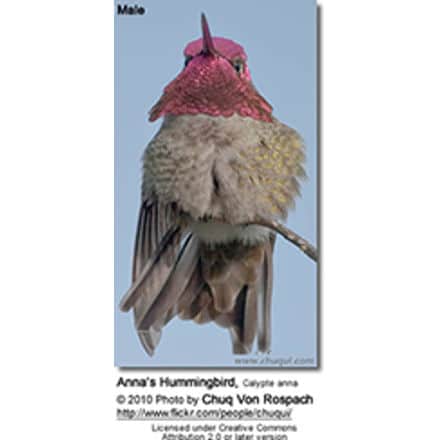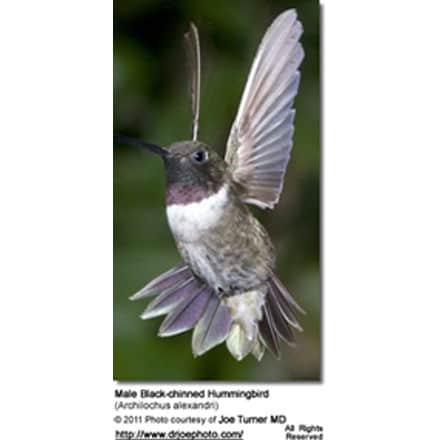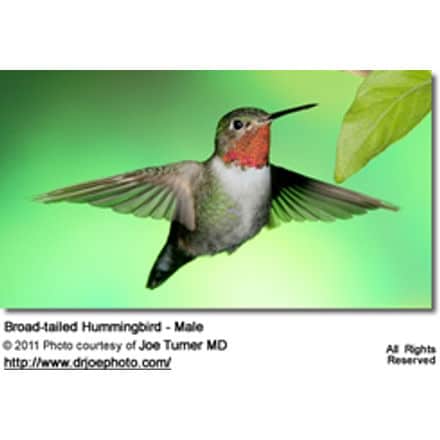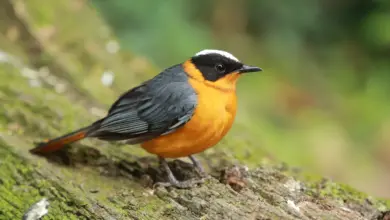Hummingbirds found in Washington State, USA
Hummingbirds found in the USA (by U.S. State) … Canada … Mexico … Puerto Rico … Jamaica … Honduras
The following hummingbird species are known to occur in Washington State.
The best time to observe hummingbirds in Washington is in the summer (especially in August) – during the post-breeding dispersal period. The juvenile and adult hummingbirds are fattening up for the long and exhausting migration south to their winter territories. All, but the Anna’s hummingbirds, will migrate south (or east) to their wintering territories.
Anna’s Hummingbirds, Calypte anna – Native year-round residents – Usually found in suburban parks, gardens and coastal valleys. Some Anna’s Hummingbirds are resident where food (flowers and feeders) and shelter is readily available. Anna’s may move seasonally to make best use of local resources, such as flowering seasons or availability of feeders – these movements are usually more to elevation than to latitude. They are relatively common in the Puget Trough; uncommon in the West Cascades; and rare in the East Cascades and along the Pacific Northwest Coast.
The largest hummingbird in that region; and the most vocal hummingbirds in the United States, where it is the only species to produce a song; specifically the males produce a complex series of scratchy noises, sounding like a sharp “chee-chee-chee; when moving from flower to flower, they emit toneless “chip” vocalizations. All other hummingbirds in the United States are mostly silent.
They are well known for their territorial behavior; the male makes elaborate dive displays at other birds and sometimes even at people. At the bottom of their dives, they produce high-pitched loud popping sounds with their tail feathers.
Males have glossy dark rose-red throats and crowns, which may appear black or dark purple in low light. The underside is mostly greyish; and the back metallic green.
Females have light grey chests with white and red spotting on the throat, greenish back and white tipped tails.
They resemble the Costa’s Hummingbirds, but the male’s Costa’s Hummingbird‘s gorget (throat feathers) is longer than that of the Anna’s. They are larger than the Rufous Hummingbirds and lack the rusty coloration of the Rufous Hummingbirds.

Calliope Hummingbirds, Stellula calliope –Native – Occur from March to August. Mostly nests in the mountains. They migrate south or east for the winter.
The smallest breeding bird in North America. They are most easily confused with the Rufous Hummingbirds and the Broad-tailed Hummingbird.

Rufous Hummingbirds, Selasphorus rufus – Native– Arrive in their breeding territory in Washington at the end of February until the end of April (mostly March). They mostly nest in the mountains. From August / September, they migrate south to Mexico and Central America for the winter.
These hummingbirds are usually found in gardens and at feeders. These birds are fearless, and are known for chasing away other hummingbirds and even larger birds, or rodents away from their favorite nectar feeders and flowers.
Males can easily be identified by their glossy orange-red throats.
Females have whitish, speckled throats, green backs and crowns, and rufous, white-tipped tail feathers.
Black-chinned Hummingbirds, Archilochus alexandri – Native Breeder – Black-chinns are the least common of Washington’s breeding hummingbirds. The males usually arrive in March and females a couple of weeks later. The males migrate back to their wintering grounds in mid- to late June, and are usually gone by the end of July. The females and young usually migrate south in July. Most Black-chinned have left by the middle of August. They are mostly found in steppe and Ponderosa pine zones (wetland areas, along rivers and in towns). Males often frequent drier areas than females.
Compared to other hummingbirds in this region, the Black-chinned has a smaller head and more slender body.
The male has a black, shimmering throat with a purple edge and pale feathers below that create a collar. However, unless the light is just right, the head looks all black. His back is green and there are some green feathers covering the chest.
The female is pale below (sometimes with a slightly speckled throat) and her back is green.

Broad-tailed Hummingbirds, Selasphorus platycercus – Rare Vagrant – Regularly nest in the mountains of extreme Northeast and Southeast Oregon. These migratory hummingbirds breed across mountain forests and meadows throughout the Western United States from eastern California and northern Wyoming south through Great Basin and Mountain states to southern Arizona and western Texas. They move south to winter in Mexico, Guatemala and, occasionally, El Salvador.
Males can most easily be identified by their iridescent, rose-red throats, white chest feathers and metallic green back and crown and their rounded tails. The males’ tails make whistling noises in flight.
Females lack the flashy throat patch of the male and are mostly pale below. Their white-tipped outer tail feathers are rust-colored close to the body and blackish in the center; the tail feathers in the center range from green to blackish.


Costa’s Hummingbirds, Calypte costae – Rare / Accidental
Males can easily be identified by the glossy purple crown and long, conspicuous throat feathers that project markedly down the side of the throats, giving it an elongated “moustache” appearance. The back is metallic green.
Females have greyish-green crowns (fop of the head) and backs. The chin and the plumage below are whitish, except for some black spotting on her throat. Her flanks are buffy-colored. She has a dark tail with white tips on the outer tail feathers.
They resemble the Anna’s Hummingbirds, but the male’s gorget (throat feathers) is longer than that of the Anna’s.

Xantus’s Hummingbirds (Basilinna xantusii) – Rare vagrants. This Mexican hummingbird has been venturing into California on a regular basis. Some travel up the Pacific coast of North America to British Columbia in Canada.
ID: White / darkish eyestripe. Mostly green above, cinnamon colored below. Males have reddish beaks with black tips; females have darkish beaks. Males have green throats and females brownish.
Hummingbird Resources
- Hummingbird Information
- Hummingbird Amazing Facts
- Attracting Hummingbirds to Your Garden
- Hummingbird Species
- Feeding Hummingbirds



